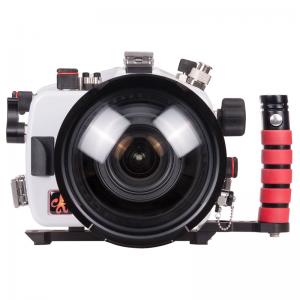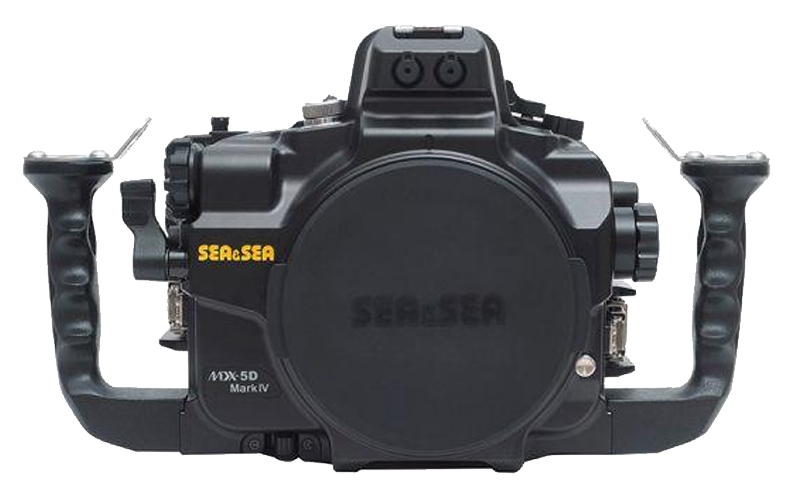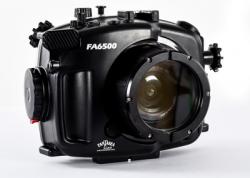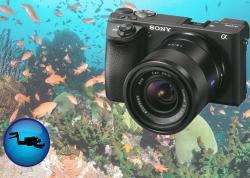Canon 5D Mark IV Camera Review
November 2016
The Canon 5D Mark IV is one of the hottest DSLRs for serious underwater photographers and videographers. Many pros had their hands on the camera as soon as it was made available, and now that housings from the major manufacturers are available, the camera is being taken on dives around the world.
The new pro-sumer DSLR is built around a brand new 30.4 megapixel full-frame CMOS sensor and incorporates Canon's dual-pixel autofocus technology (thanks Canon!!). In short, this delivers quick, reliable autofocus when shooting video in live view mode, and of course, lighting quick AF when shooting through the viewfinder. Additionally, the Canon 5D Mark IV boats a DIGIC 6+ processor, 4k video at 30fps, Full HD video at 60fps, 61 AF points (41 cross-type), touch panel LCD, and enhanced high ISO performance.
The Canon 5D Mk IV has a big legacy to step into. So does it live up to the hype? Find out in our detailed camera review below, as well as auxillary reviews by pro underwater photographers.
Status: Shipping now
MSRP: $3,499 USD (body only)
Jump to section:
5D Mk IV Specs | Highlights for Underwater Use | Body and Controls | Full Frame or Crop Sensor?
Underwater Image Quality Tests | Dual-Pixel RAW Tests | DSLR Spec Comparison
Thoughts for u/w Photo & Video | Best Lenses | 5D Mk IV Housings | Conclusion
Pro Photographer Field Reviews | Review for Underwater Video
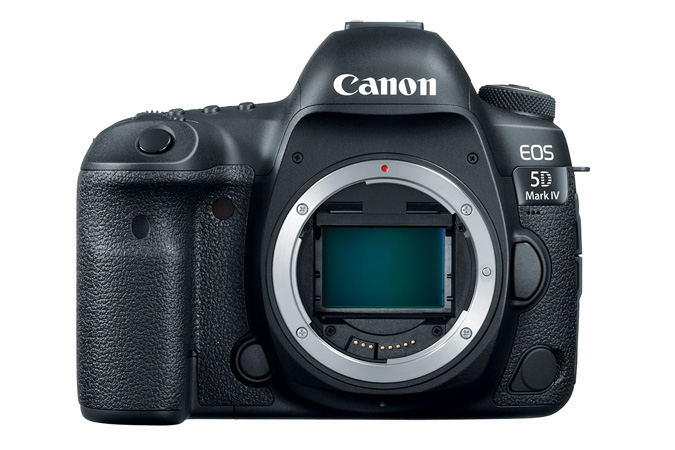

Canon 5D Mark IV Specifications
- 30.4 Megapixel full-frame CMOS sensor
- DIGIC 6+ image processor
- Dual-pixel AF sensor and continuous servo AF for stills
- AF point: 61 points (41 cross-type)
- Dual Pixel RAW recording (image microadjustment & bokeh shift capabilities)
- ISO: 100–32,000; expandable up to 50–102,400
- Continuous shooting: 7 frames / sec.
- 4K video recording at 30fps (motion jpeg, DCI standard), Full HD at 60fps (All-I), HD at 120 fps (All-I)
- 150,000-pixel RGB + IR metering sensor
- 1.62M dot 3.2" touch LCD
- Anti-flicker mode
- Interval timer (finally, thank you Canon! :- )
- Built-in GPS, Wi-Fi · NFC connection
- Media: SDXC / SDHC / SD (UHS-I enabled), CompactFlash
- The main terminal: USB 3.0, Mini-HDMI
- Size: 116mm X 151mm X 76mm
- Weight: 890g
Highlights for Underwater Use
- Fast and accurate Live View autofocus (great for video)
- Exceptional full frame image quality
- High ISO performance allows more creative settings options for wide-angle video
- Wide range of Pro (L) EF lenses for all shooting situations, underwater and topside
5D Mk IV Body and Controls
The control layout of the 5D Mark IV is very similar to the Mk III. The smaller upgrades are the new graphic on the top mode dial and the new thumb-controlled AF Area Selection button. The new AF Area Selection button (located to the right of the Q button) allows the shooter to change area modes with the thumb (in addition to the previous method of the forefinger on M-Fn button).
The major update is the touch LCD monitor. The monitor works as you would expect it to. During viewfinder shooting the touch is disabled by default, but once you press the Q button (Quick menu) then you can tap any touch menu item and then adjust those properties with touches or swipes. The return (exit to main screen) touch button appears in the lower right hand corner. During live view shooting, you can touch an area of the screen and the camera will autofocus at that point. The Quick menu button is displayed ergonomically in the upper right corner of the screen, along with the return (exit to main screen) when inside a menu. All-in-all a nice system for topside shooters, but it's not too much use for underwater shooters (note that all these controls/menus can be accessed through regular control buttons and dials).

Do you Buy a Full Frame or Crop Sensor?
Full frame cameras are becoming more and more popular among underwater photographers. Many photographers are upgrading systems to full frame and many brand new photographers are purchasing full frame as their first camera system. But even with the popularity of large sensors, the crop sensor has a strong place in the mirrorless and DSLR market, and actually excels in many areas of undewater photo and video.
So which is the right camera for you? Here's a quick breakdown:
Pros of a Full Frame Sensor
Larger sensor is more sensitive to light.
Better performance at high ISOs, specifically with electronic noise and color.
Less depth of field at the same apertures results in smoother bokeh.
Pros of a Crop Sensor
Cheaper than full frame camera body.
The standard 1.6 crop factor (1.5 on Nikon DX) essentially magnifies the image, bringing you closer to that shark swimming in the distance or to filling the frame with a small nudibranch.
You can use a lower aperture to achieve the same depth of field as a higher aperture on a full frame sensor. This is beneficial for three reasons:
Most lenses deliver their best image quality in mid-range apertures.
Higher apertures become prone to diffraction.
Lower apertures allow more light to hit the sensor, which helps bring more vibrant color from video lights (when shooting video), while maintaining necessary depth of field for the shot.
Have more questions? Contact the experts at Bluewater Photo, who can guide you to the perfect camera setup for your shooting style and budget.

Underwater Image Quality Tests
Wow, wow, wow. I've been shooting mostly compacts over the last year, and after a few frames underwater with the Canon 5D Mark IV I could already see what I've been missing in terms of image quality. Opening the raw files in Lightroom is just as much a treat. Below are my thoughts on image quality after 5 quick dives with the camera.
Before diving into image quality, it's important to note that you can have the best image quality in the world, but if you put a cheap lens in front of it you won't see the true quality. It will be a waste. So invest in nice lenses if you're splurging on a camera body like the 5D Mark IV. Dome ports follow the same principal, so make sure to use the right dome port with the right extensions for your lens in that particular shooting situation.
Dynamic Range
DxOMark gives the Canon 5D Mark IV the highest dynamic range rank of any Canon sensor (13.6 Evs). This ranks below the Sony a7R II (13.9 Evs) and Nikon D810 (14.8 Evs), but keep in mind that this is a very technical sensor test. When evaluating overal image quality, we need to look at what the camera's proprietary RAW file format does with that data.
In the sample image below you can see the full range of the Canon 5D Mark IV, which holds detail in the brightest overexposed water (upper left corner) all the way down to the dark underexposed shadows in the lower left corner. In the subsequent image I've recovered the highlights and the shadows 100%, which brings back a significant amount of detail and even nice color from the shadows.


Color Tonality
Canon has a reputation for beautiful color and the 5D Mark 4 appears to really deliver. Just look at the smooth gradation in light intensity, and minimal banding, as the blue transitions from just below the white point down to the black point in the image below.
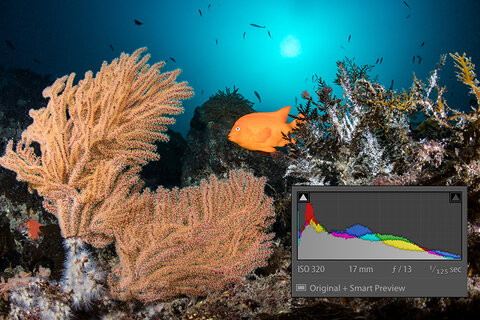
100% Crop
I've included a 100% crop of a gorgonian shot with the Tokina 10-17mm fisheye and a 4" glass minidome. The detail looks ok for a 6720 x 4480 pixel image, especially since we have to zoom in further to see the same number of pixels, losing detail as a result (*if you're used to smaller resolution Canon DSLRs. The 5DS R is an obvious exception). My gut reaction (clearly not very scientific) is that the Tokina just doesn't deliver the image quality we want to see from the 5D Mark IV, so if you're considering the Canon 8-15mm or the Sigma 15mm, I would encourage you to go with one of those lenses instead.
Pixel peeping like this is a dangerous game though. I didn't perform any microfocus adjustments on the Tokina prior to diving. I was also using a 4" dome, which presents more distortion than a larger dome.
I'll present side-by-side 100% crop comparisions with other DSLRs at the first opportunity, but suffice it to say that the 5D Mark IV has the potential to deliver nice crispy images when shot properly with the right lenses.

High ISO Shooting
(coming soon)
5D Mk IV Dual-Pixel RAW
Dual-Pixel RAW. There's a lot of talk about this. In short, dual-pixel RAW allows you to make microfocus adjustments, small bokeh shifts and correct ghosting/flare during post production. Currently this can only be performed in Canon's Digital Photo Professional and a 3rd party software called RawDigger. Adobe is reportedly working on adding support within their products in the near future. Additionally, Imaging-Resource.com reports that dual-pixel raw can recover up to a stop of data in the image highlights. Wow!
How does it work? The Canon 5D Mark IV sensor contains two photodiodes within each pixel, and each records an image. Your memory card will record twice as much information, but you will only see one raw file on the memory card.
How do you use Dual-Pixel RAW?
- First, enable dual-pixel raw recording in the camera menu.
- Next, shoot away!
- Make sure to download Canon's DDP software and use it to select and open your raw image. Notice that each .CR2 (raw) file says DPR on it.
- At the top menu, open Tools, then select 'Start Dual Pixel RAW Optimizer'.
- Make your adjustments here.
Is Dual-Pixel RAW worth it?
On certain images, absolutely. Even with microfocus adjustments on each of your Canon 5D Mk IV lenses, the AF is not always going to lock on perfectly. This is when post-processing microfocus adjustment is benefitical, as you can see in the sample image below.
![]()
Spec Comparison with other DSLRs

The Canon 5D Mark IV holds its own in a crowded prosumer space. Above are some popular cameras for underwater photo and video, however be sure not to discount the strong video capabilities of the Panasonic GH5 and the impressive specs of the soon-to-come Olympus E-M1 Mark II. Below are links to our reviews of all these cameras.
- Canon 80D Review
- Canon 7D Mark II Review
- Canon 5D Mark III Review
- Nikon D810 Review
- Nikon D500 Review
- Sony a7R II Review
- Panasonic GH5 Review (coming soon)
- Olympus E-M1 Mark II Review (coming soon)
5D Mark IV for Underwater Photography
Overview:
Canon's 5D series has a long (digital) history making game-changing full-frame DSLRs. The 5D Mark III bridged the gap between the 'landscape only' 5D Mark II and the 'sports only' 7D with a sophisticated autofocus system. The 5D Mark IV builds on this shooting versatility with dual-pixel autofocus. As underwater photographers, we need exceptional AF capabilities (sea lions, dolphins, darting gobies) plus the aspects of image quality where full frame cameras excel: maximum dynamic range, color depth, bokeh, etc.
The 30.4 megapixel sensor is a nice compromise between having enough pixels for big crops (for those tiniest of subjects) but not so many that you need a top-of-the-line computer to process. Nicely done, Canon.
The Canon 5D Mark IV is a great camera for shooting wide-angle with strobes or video lights, but also ambient light with high ISOs (think orcas or whales in dark water). The autofocus will performs well in either situation. Macro shooters will drool over the crisp color and incredible sharpness of the 5D IV paired with the Canon 100mm f/2.8L lens.
The Canon 5D Mark IV Underwater:
During my 5 dives with the camera I was in heaven. It's been over a year since shooting a full frame DSLR underwater, and the image quality was stunning - even on the little LCD screen. Being able to reference the histogram puts the creative ability far above the GoPro HERO5 - the camera I shot during our recent La Paz small group photo trip.
Autofocus was quickly achieved - even in dark water (cloud cover) using the Tokina 10-17mm fisheye and back-button focus. AF will likely be even faster with Canon lenses for macro and wide-angle shooting. Changing the AF point is the same as the 5D Mark III and 7D Mark II (and 5DS R I believe), so it will come natural to those who are upgrading. Ergonomics will depend on the housing.
Most other functions are the same as the DSLRs mentioned above, making it easy to review images, navigate the menu to adjust settings like video resolution, custom controls, manual white balance, etc. while underwater).
Stay tuned as we begin reviewing 5D Mark IV underwater housings in-depth.
5D Mark IV for Underwater Video
Canon revolutionized the digital video game with the 7D and 5D Mk II. They still reigned supreme with the 5D Mark III until the upstart Sony alpha Mark II cameras hit the scene, along with cameras like the LX100 and GH4. The Canon 5D Mark IV has some pros and some cons.
Update: We will be publishing a detailed video review by mid-December.
Pros:
Dual-pixel phase detection AF with continuous Servo AF in Live View. Most DSLR and mirrorless cameras don't have quick or reliable autofocus when shooting video, so Canon's dual-pixel AF has really upped the game in this regard, making autofocus something that video shooters can start to rely on for certain scenes. (The 7D Mark II and 80D both also feature dual-pixel AF sensors).
Second, the 4K recording uses DCI standard aspect ratio (4096 x 2160) instead of 16:9 UHD standard (3840 x 2160). This is similar to the Canon 1D X Mk II, which has been delivering excellent video quality.
Cons:
Canon's new 4K recording uses the Motion JPEG compression instead of All-I or IPB. This is excellent for pulling 8.8 MB .jpg stills from the 4K recording, but needs to use a bit rate near 500Mbps. Those shooting in 4K will be investing heavily in fast, large CF cards to handle the files, and opening their housings as much as needed to swap them out. Canon elected to use compact flash storage (along with an SD slot) instead of the new C-Fast like in the Canon 1D X Mk II. For Magic Lantern users recording RAW in-camera this is a bummer, but it doesn't change anything for those recording externally. If you're shooting at 1080 All-I, then it's business as usual.
Second, 4K recording only uses a portion of the 5D Mk IV's full frame sensor, essentially making it a 1.6 crop persective (similar to Super 35 on the Sony a7R II). What does this mean? Well, if you're switching back and forth between photos and videos, you'll also be switching between full frame and 'crop' focal distances, which use very different lenses. On land it's a quick lens swap, but underwater you're going to have to commit to one lens in your housing. Will it be the wide-angle for full frame photos or the ultra wide-angle for 'crop' video recording? Maybe this is your excuse to buy the Canon 11-24mm f/2.8L (provided the housing manufacturers plan for this)!


The Canon 5D Mark IV - side views
Best Lenses for the 5D Mark IV
The Canon 5D Mark IV uses a full frame sensor, making it compatibly with Canon's EF lenses plus compatible 3rd party lenses. Underwater photography generally falls into two categories: wide-angle and macro. The lenses below are best for shooting in these styles with the Canon 5D Mark IV (and all Canon full frame DSLR bodies).
Macro
 Canon EF 100mm f/2.8L Macro IS USM
Canon EF 100mm f/2.8L Macro IS USM
This smooth and fast lens should be in every experienced (Canon) underwater photographer's bag. It provides the magnification needed for shooting small macro subjects and the tiniest subjects when combined with a diopter on the outside of the housing port. It also happens to be the only Canon macro lens for the 5D Mark IV. View some photos shot with the Canon 100mm Macro lens on full frame bodies.
Wide-Angle Fisheye

Canon 8-15mm Circular Fisheye
This is one of several fisheye choices for 5D Mk IV shooters. A sharp fisheye at 15mm, you can also shoot this lens at 8mm without a dome port shade in order to produce circular fisheye images. Check out some examples in Wide-Angle in Bunaken or read or full Canon 8-18mm Lens Review.
Alternative Fisheye Lenses
Other great fisheye lens choices for the Canon 5D Mark IV will be the Sigma 15mm and the Tokina 10-17mm fisheye lens (between 15-17mm since this is an APS-C lens). The Sigma will likely deliver better image quality, however the Tokina is very convenient if you already have it in the camera bag.
Rectilinear Wide-Angle
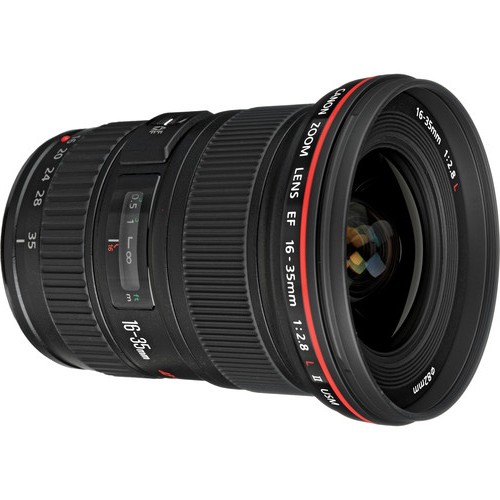
Canon 16-35 f/2.8 III Ultra-Wide Zoom Lens
This lens was announced alongside the 5D Mark IV. It's safe to say that this is the best choice for those who are buying their first wide-angle lens for the 5D IV and don't have a strict budget. Most underwater shooters use rectilinear wide-angle lenses for shooting subjects that don't come close enough to fill the frame with a wide fisheye lens: sharks, whales, sea lions, dolphins, etc.
 Canon 16-35mm f/2.8L II Wide-Angle Lens
Canon 16-35mm f/2.8L II Wide-Angle Lens
The most popular rectilinear wide-angle lens for Canon full frame DSLRs has been the Canon 16-35mm f/2.8 Mark II. This lens sat at the top of the selection for the last few years in terms of corner sharpness, speed, and price... although that will change as more new shooters purchase the version III.
 Canon 11-24mm f/4L Ultra Wide-Angle Lens
Canon 11-24mm f/4L Ultra Wide-Angle Lens
Want the widest lens you can buy? The Canon 11-24mm offers a much wider field of view than 16mm. This perspective is great for reefscapes, massive wrecks and very wide shots where you do not want the distortion of a fisheye lens. The downside is that this lens is larger, heavier and more expensive than the other wide-angle lens choices.
Alternative Rectilinear Wide-Angle Lenses
Underwater photo and video shooters on a budget will be looking towards the Canon 16-35mm f/4L or the Canon 17-40 f/4L USM wide-angle lenses. And unless you're a pixel-peeper with critical details in the corners of your images, it will be hard to tell the difference in IQ between these lenses and the popular 16-35mm f/2.8L II (we haven't tested images with the new 16-35 III yet). The quality of the dome port you are shooting through will make a much more significant difference. These lenses are also much lighter and sport 77mm filter threads instead of 82mm - which is significant for topside filter use.
Canon 5D Mark IV Housings
The Canon 5D Mk IV has a slightly smaller body than the 5D MkIII. The IV fits in most III housings natually or with a modification kit. There are also new underwater housings specifically designed for the 5D Mark IV. To add even more interest, some of these new Canon 5d Mark IV housings also work with the Canon 5DS R. Each housing is different, so we've included links to Bluewater Photo in order to get all the details.
Aquatica Canon 5D Mark IV Housing
Ikelite Canon 5D Mark IV Housing w/ Dry Lock Port Mount
Nauticam Canon 5D Mark IV Housing
Sea&Sea Canon 5D Mark IV Housing
Pro Photographer Field Reviews
Review & photos by David Fleetham: Review: Canon 5D Mk IV with Ikelite Dry Lock Port System.
Review & photos by Andy Sallmon: Review: Canon 5D Mk IV in Aquatica A5DMKIV Housing.
Review for Underwater Video
We worked with underwater videographer Mike Raabe to put together a detailed 5D Mk IV Review for Underwater Video. Be sure to check it out.
Conclusion
The Canon 5D Mark IV is a fantastic choice for Canon DSLR shooters who want a full frame instead of crop sensor (if you want a crop sensor, the Canon 7D Mark II is your best choice). A wide selection of lenses, excellent dynamic range and high ISO performance, extremely fast autofocus, 4K video and versatility will sets the bar for full frame prosumer DSLRs.
Yes, the Nikon D810 and Sony a7R II may have better technical sensor specs, but I highly advise you to look at images and video shot with all cameras instead of just this raw data. After all, we want to share the final product - not sensor data reports!
The wide range of housings fits all levels of (DSLR) budgets, and flexibility to use other backup bodies like the 5D Mk3 and 5DS R in many housings further increase the versatility of your travel kit.
Long story short, if I shot u/w photo and video seriously I'd be saving up for the 5D Mark IV as fast as possible. You should too!
Underwater Photo Gallery
(more images coming soon)
Have images shot with the Canon 5D Mark IV? We'd love to see them and maybe even share them right here. Just email Brent.

Further Reading
RECOMMENDED ARTICLES
SUPPORT THE UNDERWATER PHOTOGRAPHY GUIDE:
The Best Service & Prices on u/w Photo Gear
 Visit Bluewater Photo & Video for all your underwater photography and video gear. Click, or call the team at (310) 633-5052 for expert advice!
Visit Bluewater Photo & Video for all your underwater photography and video gear. Click, or call the team at (310) 633-5052 for expert advice!
The Best Pricing, Service & Expert Advice to Book your Dive Trips
 Bluewater Travel is your full-service scuba travel agency. Let our expert advisers plan and book your next dive vacation. Run by divers, for divers.
Bluewater Travel is your full-service scuba travel agency. Let our expert advisers plan and book your next dive vacation. Run by divers, for divers.





